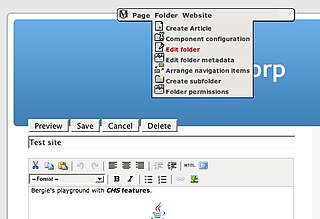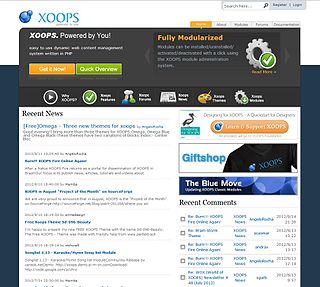Zope is a family of free and open-source web application servers written in Python, and their associated online community. Zope stands for "Z Object Publishing Environment", and was the first system using the now common object publishing methodology for the Web. Zope has been called a Python killer app, an application that helped put Python in the spotlight.

Drupal is a free and open-source web content management system (CMS) written in PHP and distributed under the GNU General Public License. Drupal provides an open-source back-end framework for at least 14% of the top 10,000 websites worldwide and 1.2% of the top 10 million websites—ranging from personal blogs to corporate, political, and government sites. Systems also use Drupal for knowledge management and for business collaboration.

Midgard is an open source persistent storage framework. It provides an object-oriented and replicated environment for building data-intensive applications.
Mambo was a free software/open source content management system (CMS) for creating and managing websites through a simple web interface. Its last release was in 2008, by which time all of the developers had left for forks of the project, mainly Joomla and MiaCMS.

XOOPS is a free open-source content management system (CMS), written in PHP. It uses a modular architecture allowing users to customize, update and theme their websites. XOOPS is released under the terms of the GNU General Public License (GPL) and is free to use, modify and redistribute.
A web content management system is a software content management system (CMS) specifically for web content. It provides website authoring, collaboration, and administration tools that help users with little knowledge of web programming languages or markup languages create and manage website content. A WCMS provides the foundation for collaboration, providing users the ability to manage documents and output for multiple author editing and participation. Most systems use a content repository or a database to store page content, metadata, and other information assets the system needs.

Joomla, also spelled Joomla! and sometimes abbreviated as J!, is a free and open-source content management system (CMS) for publishing web content on websites. Web content applications include discussion forums, photo galleries, e-Commerce and user communities and numerous other web-based applications. Joomla is developed by a community of volunteers supported with the legal, organisational and financial resources of Open Source Matters, Inc.
Kupu was a 'document-centric' open source client-side editor for Mozilla, Netscape and Internet Explorer. Inspired by Maik Jablonski's Epoz editor, it was written by Paul Everitt, Guido Wesdorp and Philipp von Weitershausen to improve the JavaScript code and architecture, pluggability, standards support, support for other webservers than Zope, configurability and a lot of other issues.
The Common Vulnerabilities and Exposures (CVE) system provides a reference method for publicly known information-security vulnerabilities and exposures. The United States' National Cybersecurity FFRDC, operated by The MITRE Corporation, maintains the system, with funding from the US National Cyber Security Division of the US Department of Homeland Security. The system was officially launched for the public in September 1999.
Monkey patching is a technique used to dynamically update the behavior of a piece of code at run-time. A monkey patch is a way to extend or modify the runtime code of dynamic languages without altering the original source code.
Cyn.in is an open-source enterprise collaborative software built on top of Plone a content management system written in the Python programming language which is a layer above Zope. Cyn.in is developed by Cynapse a company founded by Apurva Roy Choudhury and Dhiraj Gupta which is based in India. Cyn.in enables its users to store, retrieve and organize files and rich content in a collaborative, multiuser environment.

Plumi is a free software video-sharing content management system developed based on the open-source content management system Plone. Plumi allows users to create a video-sharing website by adding it to an existing Plone instance. The software includes various functions to facilitate video distribution and community creation.
Nuxeo is a software company making an open source content management system.
Buildout is an open-source software build tool. Buildout is created using the Python programming language. It implements a principle of separation of configuration from the scripts that do the setting up. Buildout is primarily used to download and set up dependencies in Python eggs format of the software being developed or deployed. Recipes for build tasks in any environment can be created, and many are already available.
ParTecs, Participatory Technologies, was an international software company specialized in Open Source Software and Free Software solutions based in Rome, Italy.
Pylons Project is an open-source organization that develops a set of web application technologies written in Python. Initially the project was a single web framework called Pylons, but after the merger with the repoze.bfg framework under the new name Pyramid, the Pylons Project now consists of multiple related web application technologies.





